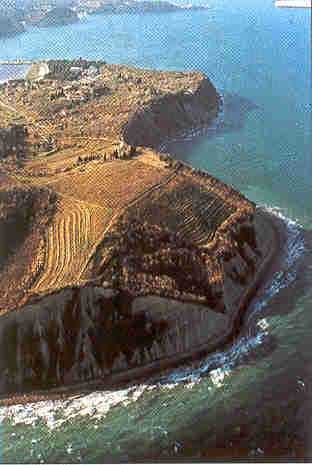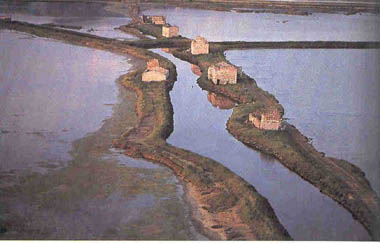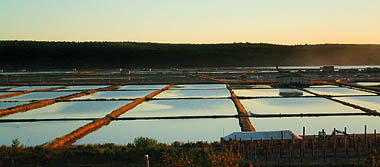|
Location
The Slovenian coast is situated at the far northern
end of the Mediterranean, along the Gulf of Trieste
which is the northernmost part of the Adriatic Sea.
The Slovenian coast is only 46 km long and is heavily
urbanised. The proximity of Trieste and other bigger
cities of Northern Italy, Austria and mainland Slovenia
makes the area interesting for tourists. They are attracted
by the diverse natural beauties (cliffs, marshes, caves,
beaches etc.) and rich cultural heritage (historic settlements,
salt-pans, traditional food etc).
|
|
|
Problems / Conflicts / Opportunities
Tourism and recreation
The area has a well developed tourist infrastructure,
which includes dozens of hotels, sports facilities and
public beaches. Most of them are in perfect condition.
The area has 21.000 tourist beds, most of them in the
municipality of Piran. It receives about 400,000 tourists
a year. Besides beach tourism, the focus of Slovenian
coastal tourism is placed on conferences, health and
casino tourism throughout the whole year. During the
last few years, eco-tourism and cultural tourism have
become increasingly important. Therefore, tourism development
of the coast sprawls outside the city into the natural
parts of the coast, into the coastal hinterland developing
new tourist attractions which can easily go beyond the
carrying capacity of the environment.
Urbanisation
The coast is heavily populated. The region spans over
an area of 344 km2 with a population of just under 80.000
people (232 inhabitants/km2). Most of the population
(over 80%) lives within the 1,5 kilometre wide strip
along the coast. The urbanisation of the coastal strip
together with the increasing employment opportunities
led to intensive migration of inhabitants from hinterland
to the coast. Among the direct consequences of this
exodus were deserted villages, the decay of urban buildings,
poor maintenance of infrastructure, abandonment of farming
and the decay of the typical cultural landscape.
In the eighties the migration process reversed, mainly
due to the greater private housing possibilities. The
change had positive effects on the revitalisation of
the hinterland. At the same time, due to poor planning
and insufficient control over building activities, the
process led to a serious degradation of the cultural
landscape. Today, the major problem of coastal cities
and settlernents lies in their extensive and dispersed
expansion into the surrounding space over the last decades.
The major changes in the narrow coastal strip over these
years (abandoning of salt production, the construction
of tourist facilities including yachtmarinas, the development
of the port of Koper and infrastructure) resulted in
a serious loss of natural coastline and degradation
of the coastal ecosystems.
|

The cliffs of Strunjan nature reserve.
(Foto Hanc J.)
|
|
Project Description
In the past decade there were several projects focused
on the protection of natural and cultural environments
from deterioration through development of eco-tourism
and cultural tourism. There were also a number of projects
that looked at various aspects of regional development
and sought for more integrated and sustainable solutions.
With the creation of the new Coastal Area Management
Programme (CAMP) the area is going to get an important
document for sustainable development of the coastal
zone together with its hinterland. Part of the CAMP
will also be the Strategy for Development of Sustainable
Tourism along the Slovenian Coast. The difference of
this particular project from similar projects is that
the area includes a large part of the hinterland and
that the process of preparing the documents anticipates
extensive community involvement.
|

Salt-pans of Secovlje. (Foto: Klemenc S.)
|
|
COMMENTS AND THEORY
An important strategy of sustainable tourism is diversification
of the tourism product from beach tourism to other types
of tourism which are not linked only to the coast but
also to its hinterland.

The saltpans of Secovlje, Slovenia. Foto: Jaka Adamic.
|
Results
The most important result of regional development and
heritage protection activities in the coastal area has
been the recognition that there is a need for cooperation
among all stakeholders to be able to solve growing environmental
problems. Furthermore, preparation of a fully integrated
aproach towards sustainable development is essential.
Another important result of the last-decade-activities
are extensive protected areas of natural and historical
sites along the coast. Nature reserves include cliffs,
lagoons, underwater habitats, salt marshes, salt-pans,
reserves of mediterranean terrestial flora and fauna
and as well as freshwater lakes.
Protected nature heritage sites are:
- Secovlje natural resort that includes salt-pan
and Seca peninsula - it is also Ramsar locality;
- Strunjan natural resort that includes steep cliffs
along the seashore;
- Skocjanski Zatok.
and others that are not yet fully protected. These
sites are not only managed because of their intrinsic
ecological value. They are also regarded as part of
a valuable network of attractive areas that are used
for diversifying the tourism product
|
|
Who, Where and When
There is no coordinating body for the sustainable tourism
process yet. The whole process of moving towards sustainable
tourism started in early 90s because of the need to
protect natural heritage sites along the coast. At that
time, the sustainable tourism concept seemed to offer
the right directions for protection and development
of sensitive areas with high ecological or cultural
value. The initial steps to develop Integrated Regional
Development Plan for Coastal Area of Slovenia were concluded
in March 2002. In September 2003, a new phase of this
process started with the preparation of CAMP which will
be concluded by the end of 2005. The project is prepared
in the framework of the Barcelona convention and the
Mediterranean action plan (UNEP/MAP). It is coordinated
by the Ministry of Environment, Physical Planning and
Energy of Slovenia. Financial resources are also contributed
by the coastal municipalities.
|
|
Exercise for user
What kind of tourism can be developed to diversify
the tourism product and to unburden the coast?

|
|